|
MESSAGE FROM THE OWNER
Are organic, natural and sustainable yesterday's food labels? (Part 2)
In Premier's previous newsletter my comments about the future merits of the organic, sustainable and natural labels surprised and offended some readers. Therefore, a little personal background and an expanded explanation of my views about the future may be in order. My father switched from "chemical" to "organic" farming on our 160-acre Iowa farm in 1955, when I was 9 years old. This change was encouraged in part by reading J.I. Rodale's monthly magazine, Organic Gardening and Farming, which we studied at length.
My folks had a true family (8 children) farm for decades:
| •
| Milked up to 5 cows by hand and sold the cream.
|
| • |
Raised chickens (hundreds) and sold the eggs.
|
| • |
Had a large vegetable and fruit garden for our personal needs, weeded, mulched and harvested by hand labor.
|
| • |
Raised a limited number of sheep, pigs and beef cattle. We butchered and processed meat from them for the family and sold the rest.
|
| • |
Grew corn, wheat, hay, oats and soybeans, but not many acres of each.
|
| • |
Heated our home with wood from trees on the farm.
|
In short, it was the complete opposite of modern specialized farms. The most important product wasn't the food. Instead it was the education and development of the 8 children and our city cousins who visited us each summer. We learned how to think, accomplish, suffer and sweat.
In 1964, I went to Iowa State University and used its excellent library to read every organic/natural farming author on hand, including Howard, Faulkner and Bromfield. In 1965 I switched to Ambassador College, a small, conservative religious college that actively supported and practiced organic farming and gardening.
Two years later I transferred to Ambassador's British campus north of London. Its farm and gardens produced organic milk, meat (chickens and beef), eggs, vegetables and fruit for the student and faculty kitchens. In my senior year I was paid (even now I marvel at this!) to read extensively about organic food and food production for the college's Agricultural Department and prepare summary reports therefrom.
I stayed on after graduation to manage the college's farm and vegetable gardens. By the time the college closed (1974), the farm operation had grown to 300 acres, 1000 chickens, 5 acres of fruit/vegetable gardens and 150 dairy and beef cattle.
Over 6 years the head of Ambassador's Agricultural Department and I visited research farms and agricultural shows all across Britain, Europe and the USA. We listened and talked with folks like E. F Schumacher, whose book Small is Beautiful—Economics as if People Mattered, is probably even more applicable now than it was in the early 1970's. In 1973 I had the privilege to share a lunch in Emmaus, Pennsylvania, with Robert Rodale (now deceased) and Wendell Berry (alive, and a thought-leader that I respect highly).
So I have roots developed over 6 decades in organic farming and ecologically sound land utilization.
Why therefore did I suggest that producers might consider supplemental labels to organic, natural and sustainable in my previous newsletter?
| 1. |
Because the astute marketing minds of the big "industrial" food producers have already spotted the $$ potential of these labels. Therefore, "organic" labels will soon be commonplace (and may be often attached to food whose production systems may be questionable).
In turn, the smaller producers who began it all will feel pushed out. That's why it's sensible, in my view, to anticipate this — and also attach supporting labels like "no antibiotics, local and/or hormone-free." The nature of large-scale food production makes it more difficult to honestly replicate the extra labels (particularly local and no antibiotics).
|
| 2. |
Because, and this is an opinion developed over 6 decades, I think there is a second, and larger, group of valuable food consumers who are not overly concerned whether their food comes from an organic source. Nor do they care whether the source is a large operation or a small one.
Instead, they want the food source to be one that practices stewardship, that demonstrates integrity (honest, genuine, reliable) and proactively cares for land, animals, employees — and their customers. If they find that the source is too focused on profit as opposed to these things, they will seek an alternative. And they want to buy from people who — to paraphrase E.F Schumacher — "view food production as if people/soil/animals/plants matter, not just for profit and efficiency."
|
Best wishes to you all through the holiday season and beyond.
Stan Potratz, Owner
COMING SOON
2013 "Poultry Solutions!" catalog
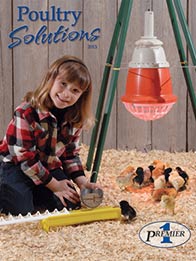
Look for Premier's new annual "Poultry Solutions" catalog in your mailbox starting the first week of January.
The Folks at Premier.
|
This year, in addition to our popular products that have pleased both Premier and our customers for years, we're offering the following new products:
New Products Now available:
Blenheim Feeder
Brooders (reusable or cardboard)
Classic Bucket Waterer
Wooden Nest Egg
Color Egg Cartons
New Products Coming soon:
King Feeder without grill (green)
King Feeder grill (black)
King Feeder Rain Hat (black)
ANNOUNCING
New!
A Guide To All Things Sheep©
A Guide To All Things Sheep
has 9 subsections:
| 1. Highlights |
| 2. How-To's |
| 3. Industry Spotlights |
| 4. Education |
| 5. Features |
| 6. View Points |
| 7. Photo Gallery |
| 8. Recipes |
| 9. Event Calendar |
New articles have been added and we welcome information from you to add to our Guide:
Sheep Events. Please email complete information to rfishback@premier1supplies.com and in the subject line state "Guide Sheep Event".
Sheep Photos. Please email us your photos with information about the photo to rfishback@premier1supplies.com and in the subject line state "Guide Photos".
PREMIER TIP
Show Box 101
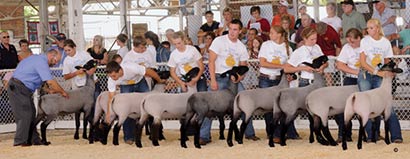 |
For many youth and parent teams across the country, opening the show box and getting ready for another exciting show season can never come soon enough. Every showman has some unique items that can be found in their show box, but there are always a few items that are considered "must haves" for quality care.
Halters are an essential tool for training sheep, from leading and washing to loading and restraining.
Halters are used every day. Whether you are looking for a basic, functional halter or something with a little more eye appeal, we offer several types of halters for the exhibitor to choose from.
Foot health and care is vitally important for all animals. A favorite trimmer among many is our ARS 140DXR. This trimmer is small and easy to use for every hand size. The ARS 140DXR is sharp and thus requires less hand strength than others to operate.
When it comes to identification, Premier offers over 10 different sizes and styles of ear tags that can be customized with color, print and/or logos to meet your needs! We also supply tattoo equipment if needed.
Preparing your animal to be show ready takes a very important piece of equipment-a clipping machine. Our 4000c clipping machine is a top choice for many exhibitors across the country. I know firsthand, because I have had mine for 10 years! You can always find sets of super surgical, surgical and a few fine blade sets in my show box along with several bottles of white clipping oil. I've learned that making sure to keep enough oil and sharpened blade sets is extremely important.
Need to remove rough wool off lambs at the beginning of the season or to trim out your breeding sheep for the next string of shows? Convert your clipping machine to a shearing machine by switching the heads!
What's the easiest way to trim your sheep? Use a Premier trimming stand. The trimming stand is hot-dip galvanized steel that's quick and easy to move and store. Make a 2-person job much easier and safer by using the ramp and side rails to get the sheep on the stand and keep it there as well.
And last but not least, do you want to make your barn more efficient? If so, you may want to start by making individual pens. Separate pens make it much easier to feed and care for your animal on an individual basis. Our PowerBilt panels for pens make great additions to any barn! They come in various sizes to meet your flock or show string size and take only minutes to set up. You can use wire connector hinges, connecting pins or linking stakes with the appropriate bolt to connect to the wall with ease.
By Andrea Beatty, Premier sales consultant
See Premier's Clippers & Shearers, click here.
VIP ARTICLE
Critical Nutrition Inputs for Lamb Survival
by Dr. Dan Morrical
Iowa State University
Introduction:
Sheep nutrition and feeding is extremely critical to the success or failure of the ewe flock enterprise. As shepherds, our task is to provide balanced rations to meet the ewe’s nutrient requirements on the least costly basis. Feed costs account for half the cost of producing lamb and wool. Therefore, cost control must always be foremost in the shepherd’s mind. Sheep enterprises face a greater challenge in meeting needs of the flock because of the large within-flock and between-flock variations. This paper reflects the general guidelines for feeding ewes; however, each operation must adapt and modify these guidelines for their specific operation.
Nutrient Requirements:
The amount of nutrients the sheep require is affected by several factors. These include ewe age and weight along with stage of production and level of production. Figure 1 outlines the stages of production and demonstrates how nutrient requirements change through the production cycle. It is important to realize that all ewes in the flock are not at the same stage of production on any given day. This factor is affected by the length of the breeding season and the production system (once-a-year lambing versus accelerated lambing systems).
Critical phases of the production cycle include flushing/breeding as it sets the maximum drop rate for flock. Early/mid gestation is critical in that placental development occurs from day 30 to 90 of gestation. Placental size or weight effects nutrient transfer between the ewe and fetuses. Underdeveloped placenta results in smaller birth weights regardless of late gestation nutrition. Twenty days of severe underfeeding or 80 days of slight underfeeding will both retard placental growth. The remainder of this paper will deal with late gestation and lactation stages of production since most flocks are grazing during other production phases.
Late Gestation Nutrition:
Determining how much to feed ewes in late gestation is a very difficult practice without fetal scanning. The goal of late gestation nutrition program is to insure adequate nutrient intake for strong vigorous lambs of moderate birth weight. Additionally, ewes must enter lambing season in average to above-average body condition to maximize milk production. Adequate birth weight of lambs is critical to a successful lambing season since small lambs have less resistance to cold stress and reduced preweaning growth. Excessively big lambs increase the incidence of lambing problems and increase shepherd labor and lamb death loss. Fetal scanning and the separation of ewes into different feeding groups for those carrying singles versus twins versus triplets or more helps to reduce the really big singles or small twins and triplets. Experienced technicians have accuracy values above 90% on fetal numbers, so contracting an experienced scanner is the key to successful implementation of this technology.
The nutrients of greatest concern during late gestation feeding would be energy (TDN), crude protein (CP), calcium, selenium, iodine and vitamin E. The TDN level required is affected by the number of fetuses and cold stress. Winter lambing ewes generally cannot consume enough forage alone to meet their energy requirements, thus requiring the feeding of concentrates (corn).
Fetal growth accelerates rapidly during late gestation. Furthermore, energy required is much higher for the 2 weeks prelambing versus 6 weeks prelambing. A means of controlling costs is to step up grain feeding as lambing approaches. Ewes carrying singles require less grain and do not need to receive grain as early as those carrying multiples. Late gestation rations should begin 5 to 6 weeks prelambing for ewes carrying triplets. Those with twins can be delayed to 3 to 4 weeks prelambing whereas those with singles can be held off until 2 weeks prelambing.
The absolute level of grain to feed is highly dependent upon the nutrient density of the forage being fed. Table 2 demonstrates the huge variation in nutrient density of hays. Nutrient analysis costs $15 to $25 per sample and is money well spent. Balancing diets based on average or book values for hay is a risk progressive shepherds should not take, especially in highly productive flocks. Furthermore, one cannot accurately determine the nutrient density of hays with visual appraisal. Table 1 provides example rations for all phases of production with a wide array of forage sources. To minimize the risk of acidosis from excess grain feeding, ewes receiving over 1.5 pounds of concentrate per day should receive it in split feedings.
Selenium and vitamin E are both critical micronutrients for lamb survival and a smooth lambing season. Selenium can be added to the ration of sheep at .3 PPM or .3 mg/kg of feed. The maximum allowable selenium intake from supplemental sources cannot exceed .69 mg per head per day. This is a very small amount and extreme care is required in calculating how much to add. More importantly, selenium at 2 PPM can be toxic. Selenium status of ewes is dependent upon both the selenium concentration and intake of the mineral, along with the selenium level in the feedstuffs. For flocks with a history of selenium problems in newborn lambs, consider force-feeding selenium via the grain mix. This insures all ewes consume adequate amounts on a more uniform basis. If selenium is force fed, there should not be a free choice selenium source available. Table 3 shows the level of intake required for various selenium concentrations in the mineral or trace mineral salt. Selenium crosses the placenta so newborn lambs' selenium status is totally dependent upon the selenium of their dams in late gestation.
Vitamin E, unlike selenium, is not toxic. Vitamin E does not cross the placenta so a newborn lambs' only source of E is ewe’s milk or injections. The concentration of Vitamin E in ewe’s milk or colostrum is directly correlated with the Vitamin E intake of the ewe. Vitamin E levels are extremely variable in feedstuffs because the E denatures with storage and is also denatured in the rumen as grain feeding increases. As a rule of thumb I suggest feeding 100 international units (IU) per ewe per day for each lamb she is carrying or nursing.
We all know iodine is connected with basal metabolic rate. The primary symptom of iodine deficiency is goiter. SDSU and ISU diagnostic labs both report selenium and iodine are the two most common micro-mineral deficiencies. The 2007 NRC for Small Ruminants drastically increased the iodine requirements in late gestation for ewes. Iodine requirements are further increased in cold environments. Most commercial mineral supplements for sheep contain inadequate iodine concentrations to meet these higher requirements. A practical solution is to provide iodized salt blocks in combination with the mineral source. If stillbirths and hypothermia are common causes of your lamb losses, then iodine deficiency may be an issue in your flock.
Lactation Nutrition:
Lactation is the phase of production with the highest nutrient demand as shown in Figure 1. The amount of nutrients required is dependent upon the number of lambs nursed. Because of the huge differences in requirements, the most important time to split the flock into production groups is during lactation. Ewes peak in milk production around 21 days of lactation and should sustain high milk production levels through 6 to 8 weeks of lactation. Nutrient requirements in Table 1 are based on projected milk yield when individual lambs are gaining .75, .65 and .5 respectively for singles, twins and triplets respectively from birth to weaning. Calculations are based upon a standard of 4 pounds of ewe milk being required per pound of nursing lamb gain when creep feed is available. Using this standard one can assume a ewe nursing twins gaining a pound per day each and with creep feed access would be producing 8 pounds of milk per day. This is a very high level of milk production that cannot be sustained without high feeding levels.
Protein and energy are both critical nutrients for milk production. If either nutrient is fed below the requirement, milk yields and subsequently lamb gains will be reduced 10% or more depending upon the magnitude of the shortfall. I would suggest that almost all ewes lose weight during lactation, many over 35 pounds. This occurs because energy intake is well below requirements and ewes must mobilize body stores to sustain milk production. Weight loss during lactation is the critical reason that late gestation nutrition must be adequate to insure ewes are in average or better body condition at lambing. Traditionally, fat mobilization during lactation was considered as a means of controlling feed costs. However, excess weight loss is not without its costs. Ewes losing less than .5 condition score during a 60-day lactation will not suffer in terms of milk yield. Since one condition score equates to an 11% change in body weight, a 200-pound ewe could only lose 11 pounds (200 x 5.5%). This value would equate to less than .2 pounds of weight loss per day. It would not be uncommon for many ewes to lose 2 to 3 times this amount.
Weight loss during lactation impacts protein requirements. The more weight ewes lose, the higher their protein need. This situation is due to the ewe’s ability to effectively mobilize body fat but having minimal ability to mobilize body protein for milk synthesis. It is also important to realize that fat conversion to milk is about 60% under protein and energy deficient rations whereas with adequate protein fed, fat conversion to milk is 80%. To demonstrate this relationship between protein requirements and weight loss, a ewe losing .5 pounds per day requires a lactation ration containing 21% crude protein. However, if the energy intake is increased to prevent weight loss, this ewe would require only 11.5% crude protein in their ration.
Lactation nutrition mistakes:
One of the most common mistakes inexperienced shepherds make is overfeeding grain to the ewes in the lambing jug. This situation most frequently occurs when we try to accelerate the milk output in ewes that do not have enough to feed their lambs. This overfeeding can create problems with acidosis and lead to less milk production rather than more. Newborn lambs probably do not consume more than 10% of their bodyweight in the first day or two of life, so it is not critical that ewes be pushed in while in the jug.
The next mistake that needs to be avoided is overfeeding the ewes in the week to 10 days before weaning. Many flocks routinely wean ewes while in the peak stage of milk production. It is critical that shepherds modify the preweaning diet of ewes to reduce mastitis problems. This is easily accomplished by cutting off the grain feeding for the last 10 days before weaning along with feeding low-quality hay. This management input is trying to limit the ewe’s protein and energy intake as both nutrients are required for milk production. Feeding straw for the last 2 to 3 days before weaning further shuts down milk production. After weaning, ewes should be maintained on low-quality feed for 3 to 7 days to assist ewes in drying up. Lastly, if ewes are fed by number nursed, it is important to move ewes to the next lower ration if they lose a lamb or lambs.
Table1. Example rations for 175 ewes in various stages of production.
 Click to enlarge
Click to enlarge
Example rations for 200 ewes in various stages of production.
 Click to enlarge
Click to enlarge
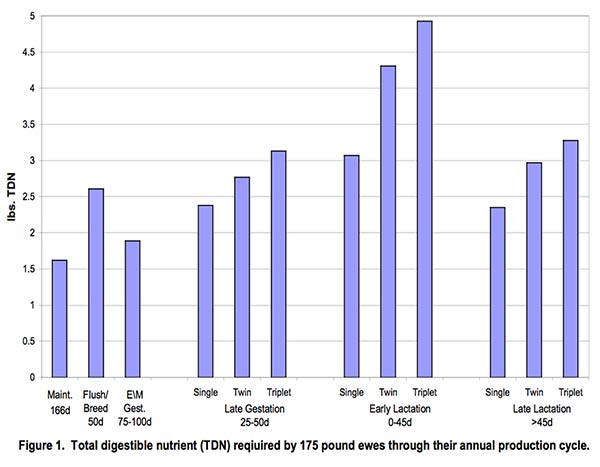 Click to enlarge
Click to enlarge
Table2. Example rations for 175 ewes in various stages of production.
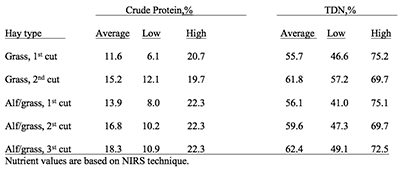 Click to enlarge
Click to enlarge
Table 3. Trace mineral salt or mineral intake required for .69 mg selenium intake a.
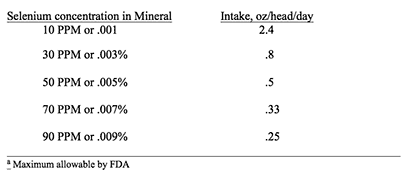 Click to enlarge
Click to enlarge
Premier Spotlight
Premier Product Spotlights
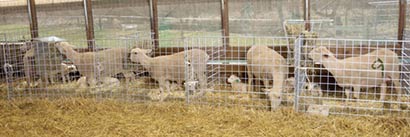
There are quite a few items that I consider essential for my lambing kit. A kit stays in each barn during the lambing season so it's never far away.
Lambing Kit
| • |
Nasal syringe. If I have to pull a lamb or come across a just-born lamb, I clear out its nose with this syringe so the lamb can breathe easier. Just squeeze out the air, insert the syringe into the nose and let it un-squeeze. Simple as that.
|
| • |
Red rubber tubes. During the colder months, I prefer the red rubber tubes for tubing lambs. Not as stiff as the plastic. Some prefer the plastic, but I prefer the rubber ones.
|
| • |
Iodine navel cup.I keep one hanging on the lambing jug so it's always on hand for dipping a lamb's navel. Make sure to have Triodine on hand as well.
|
| • |
Digital thermometer-Allows me to know exactly what temp a lamb is. It's a little more accurate than sticking your finger into a lamb's mouth.
|
By Mike Corderman, Premier's Shepherd
Bottle Rack for lambs & kids
If you feed lambs or kids with a bottle, this is a must. Just hang a bottle rack (one per animal) on the panel of your orphan pen and drop a bottle in and walk away. You can do the rest of your chores while the orphans are eating. No more trying to hold a bottle in each hand and one between your legs. Can be easily adjusted to fit different ages of animals by moving the rack up or down the panel.
Drawbacks are that it will only hang on panels, not wood or bar gates. You must cut the teats correctly or they will leak if the animal stops drinking.
By Gordon Shelangoski, Premier Sales Consultant
Classic Poultry Feeders and Classic Poultry Waterers
I appreciate any item that saves time when doing chores. For feeding and watering chicks in the brooder, I will never use anything but the Classic Feeder 2 lb #540022 and the Classic Waterer .25 gal. #540007.
I have used other feeders and waterers in the past for brooding chicks, but nothing solved the common problems of waste in the food and water. The chicks would perch on anything they could get onto. They scratched the grain out of the tray and wasted it. There was always a risk of having a chick fall into the water tray and possibly drown. I was growing tired of repeated cleanings for both the feeder and waterer every morning and night.
I tried the Classic Feeder and Waterer thinking it wouldn't hurt, the price was great and I like to try new things. I assumed it wouldn't help with the waste problem that just kept recurring but I was wrong. The cone-shaped plastic top has a smooth surface that allows feed to slide down and not stick to the sides. The same surface on the outside keeps chicks from perching and doesn't provide a ledge for them to grip onto.
The bottom tray of the Classic Feeder has a built-in grid that keeps them from scratching out feed. It also keeps the feed level from getting too high where it normally would be wasted. I have had absolutely no waste made by bird or bedding in this feeder. I cannot say that for any other feeder I have used before.
The best thing about the Classic Drinker is the base. The tray is narrow enough so that no chick can fall into it, but it doesn't prevent the chicks from getting a drink. With the push-fit base, it was extremely easy to fill with less mess. I placed it on a brick to keep any loose bedding from falling into it. I now save time because I don't have to clean each time they need more feed or water. This makes my chicks and me very happy.
By Kolby Freeman, Premier Sales Consultant
|